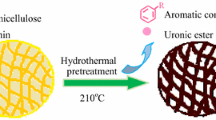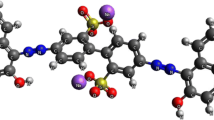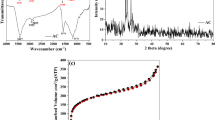Abstract
This study explores preparation (thermally) and activation (chemically) activated carbon from Manilkara Kauki L. bark (MKB) for the removing of Congo red (CR) dye by batch adsorption method. The surface characteristics of the MKBC were analyzed using SEM and FTIR. Variable experimental parameters, including initial concentration, contact time, and pH, were used to test the MKBC adsorption capacity to remove CR dye. The dye solution pH was alkaline, which favored CR absorption. The Langmuir model well modeled the equilibrium adsorption data. It had an adsorption capability of 3.029 mgg−1 in MKBC and 148.08 mgg−1 in CAC. The best model for adsorption kinetics in pseudo-second order. As a result, the optimum MKBC can serve as a cost-effective and active adsorbent for removing dyes from industrial wastewater.







Similar content being viewed by others
Availability of data and materials
Not applicable.
References
Tongmee B, Mukdajaturaphak N, Unpaprom Y, Ramaraj R, Pimpimol T, Whangchai N (2021) Waste to wealth: a sustainable circular bioeconomy approach of chicken manure powder for increasing productivity of Lanchester’s freshwater prawn (Macrobrachium lanchesteri). Maejo Int J Energy Environ Comm 3(1):15–19
Van Tran G, Unpaprom Y, Ramaraj R (2020) Methane productivity evaluation of an invasive wetland plant, common reed. Biomass Convers Bioref 10:689–695
Saengsawang B, Bhuyar P, Manmai N, Ponnusamy VK, Ramaraj R, Unpaprom Y (2020) The optimization of oil extraction from macroalgae, Rhizoclonium sp. by chemical methods for efficient conversion into biodiesel. Fuel 274:117841
Dang TD, Gotore O, Ramaraj R, Unpaprom Y, Whangchai N, Xuan TB, Mased M, Itayama T (2021) Application of corncob derived biochar for removal of fluoroquinolones. Biomass Conv Bioref. https://doi.org/10.1007/s13399-020-01222-x
Obey G, Sittisom P, Ramaraj R, Unpaprom Y, Van GT, Itayama T (2019) Study of bioremediation of water environment using constructed wetland for ecological engineering and bioenergy generation from biomass recycling. Maejo Int J Energy Environ Comm 1(1):53–57
Aye KL, Itayama T, Shwe KP, Tasaki K, Hayata Y, Tada A (2019) Study on dynamic behaviors of water quality and mechanisms of eutrophication in Kandawgyi Lake, Yangon City, Myanmar. Maejo Int J Energy Environ Comm 1(3):39–46
Salim SD, Hadibarata T, Elwina E, Dewi R, Alaraidh IA, Al-Ghamdi AA, Alsahli AA (2019) Development of activated carbon from Eichhornia Crassipes via chemical activation and its application to remove a synthetic dye. Biointerface Res Appl Chem 9:4394–4400
Demirbas A (2009) Agricultural based activated carbons for the removal of dyes from aqueous solutions: a review. J Hazard Mater 167:1–9
Al-Tohamy R, Ali SS, Li F, Okasha KM, Mahmoud YA, Elsamahy T, Jiao H, Fu Y, Sun J (2022) A critical review on the treatment of dye-containing wastewater: ecotoxicological and health concerns of textile dyes and possible remediation approaches for environmental safety. Ecotoxicol Environ Saf 231:113160
Falaki Z, Bashiri H (2021) Preparing an adsorbent from the unused solid waste of Rosewater extraction for high efficient removal of Crystal Violet. J Iran Chem Soc 18:2689–26702
Pallarés J, González-Cencerrado A, Arauzo I (2018) Production and characterization of activated carbon from barley straw by physical activation with carbon dioxide and steam. Biomass Bioenergy 115:64–73
Kristanti RA, Hadibarata T, Al Qahtani HMS (2019) Adsorption of bisphenol A on oil palm biomass activated carbon: characterization, isotherm, kinetic and thermodynamic studies. Biointerface Res Appl Chem 9:4217–4224
Ma X, Li L, Chen R, Wang C, Zhou K (2018) Li H (2018) Porous carbon materials based on biomass for acetone adsorption: effect of surface chemistry and porous structure. Appl Surf Sci 459:657–664
Bhattacharyya KG, Gupta SS, Sarma GK (2015) Kinetics, equilibrium isotherms and thermodynamics of adsorption of Congo red onto natural and acid-treated kaolinite and montmorillonite. Desalination Water Treat 53:530–542
Sultana M, Rownok MH, Sabrin M, Rahaman MH, Alam SN (2022) A review on experimental chemically modified activated carbon to enhance dye and heavy metals adsorption. Cleaner Eng Technol 6:100382
Kumar P, Ramalingam S, Sathishkumar K (2011) Removal of methylene blue dye from aqueous solution by activated carbon prepared from cashew nut shell as a new low-cost adsorbent. Korean J Chem Eng 28:149–155
Ofgea NM, Tura AM, Fanta GM (2022) Activated carbon from H3PO4-activated Moringa Stenopetale Seed Husk for removal of methylene blue: optimization using the response surface method (RSM). Environ Sustainability Indic 16:100214
Ahmed W, Xu T, Mahmood M, Núñez-Delgado A, Ali S, Shakoor A, Qaswar M, Zhao H, Liu W, Li W, Mehmood S (2022) Nano-hydroxyapatite modified biochar: insights into the dynamic adsorption and performance of lead (II) removal from aqueous solution. Environ Res 214:113827
Babakir BA, Abd Ali LI, Ismail HK (2022) Rapid removal of anionic organic dye from contaminated water using a poly (3-aminobenzoic acid/graphene oxide/cobalt ferrite) nanocomposite low-cost adsorbent via adsorption techniques. Arab J Chem 15(12):104318
Kavitha D, Namasivayam C (2007) Experimental and kinetic studies on methylene blue adsorption by coir pith carbon. Bioresour Technol 98(1):14–21
Kumar P, Ramalingam S, Sathishkumar K (2011) Removal of methylene blue dye from aqueous solution by activated carbon prepared from cashew nut shell as a new low-cost adsorbent. Korean J Chem Eng 28:149–155
Al-Salihi S, Jasim AM, Fidalgo MM, Xing Y (2022) Removal of Congo red dyes from aqueous solutions by porous γ-alumina nanoshells. Chemosphere 286:131769
Mubarak M, Islam MS, Yoon DY, Lee JH, Park HJ, Bae JS, Lee HJ (2021) Flower-like Mg/Fe-layered double oxide nanospheres with ultrahigh adsorption efficiency for anionic organic dyes. Colloids Surf A Physicochem Eng 618:126446
Fernandez J, Jarvis P, Brookes A, Knott S, Carra I (2021) Organic matter removal with bicarbonate-form ion exchange: water quality, kinetics and mass transfer mechanisms. J Water Process Eng 44:102337
Dutta S, Gupta B, Srivastava SK, Gupta AK (2021) Recent advances on the removal of dyes from wastewater using various adsorbents: a critical review. Mater Adv 2:4497–4531
Achour Y, Bahsis L, Ablouh EH, Yazid H, Laamari MR, El Haddad M (2021) Insight into adsorption mechanism of Congo red dye onto Bombax Buonopozense bark Activated-carbon using Central composite design and DFT studies. Surf Interfaces 23:100977
Nayagam JO, Prasanna K (2021) Utilization of shell-based agricultural waste adsorbents for removing dyes: A review. Chemosphere 3:132737
Malik PK (2003) Use of activated carbons prepared from sawdust and rice-husk for adsorption of acid dyes: a case study of Acid Yellow 36. Dyes Pigments 56:239–249
Hameed BH, Ahmad AA, Aziz N (2007) Isotherms, kinetics and thermodynamics of acid dye adsorption on activated palm ash. J Chem Eng 133:195–203
Acknowledgements
The authors thankfully acknowledged the Department of Chemistry, Rani Anna Government College for Women and Department of Chemistry, Lekshmipuram College of Arts and Science, Affiliated to Manonmaniam Sundaranar University, Tirunelveli, India, for the research facilities to accomplish this experimental study.
Author information
Authors and Affiliations
Contributions
Rajeswaran Ramaraj: conceptualization, methodology, data analysis, manuscript writing, and editing. Banumathi Nagarathinam: methodology, proofreading, editing. Tanabe Shuji: resources and methodology. Muthirulan Pandi: funding acquisition, resources, supervision, proofreading, editing.
Corresponding author
Ethics declarations
Ethical approval
Not applicable.
Conflict of interest
The authors declare no competing interests.
Additional information
Publisher’s note
Springer Nature remains neutral with regard to jurisdictional claims in published maps and institutional affiliations.
Rights and permissions
Springer Nature or its licensor (e.g. a society or other partner) holds exclusive rights to this article under a publishing agreement with the author(s) or other rightsholder(s); author self-archiving of the accepted manuscript version of this article is solely governed by the terms of such publishing agreement and applicable law.
About this article
Cite this article
Ramaraj, R., Nagarathinam, B. & Pandi, M. Biomass-derived activated porous carbon from Manilkara kauki L. bark as potential adsorbent for the removal of Congo red dye from aqueous solution. Biomass Conv. Bioref. 13, 9475–9485 (2023). https://doi.org/10.1007/s13399-023-03969-5
Received:
Revised:
Accepted:
Published:
Issue Date:
DOI: https://doi.org/10.1007/s13399-023-03969-5




